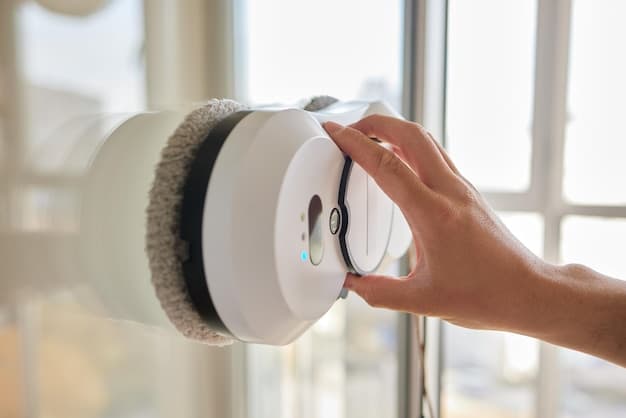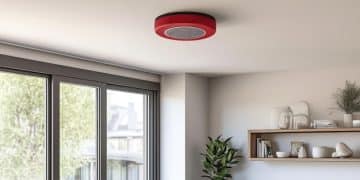Smart Home Maintenance: Troubleshooting & Prevention

Anúncios
Proactive smart home maintenance is crucial for ensuring device longevity, optimal performance, and seamless integration, while preventing common issues and minimizing costly repairs.
The dawn of the smart home era has undeniably transformed the way we live, offering unparalleled convenience and efficiency. However, just like any complex system, these interconnected ecosystems require diligent oversight. Understanding Smart Home Maintenance: Troubleshooting Common Issues and Preventing Problems is not merely about fixing what’s broken, but about nurturing your connected living space to ensure its longevity and peak performance.
understanding your smart home ecosystem
Navigating the landscape of smart home technology can initially feel daunting, given the myriad of devices, protocols, and platforms available. However, a foundational understanding of your smart home ecosystem is the first step towards effective maintenance. This ecosystem typically comprises a central hub or controller, various smart devices (such as lights, thermostats, security cameras, and speakers), and the network infrastructure—primarily Wi-Fi—that connects them all. Each component plays a vital role, and their harmonious operation depends on proper setup and regular attention.
A common misconception is that smart devices are “set and forget.” While they are designed for convenience, their reliance on software, firmware, and network connectivity means they are subject to updates, potential bugs, and signal interference. Recognizing the interconnectedness of these elements is crucial. A problem with one device can sometimes cascade, affecting others or even the entire system’s performance. For instance, a struggling Wi-Fi router might not only cause a smart speaker to constantly buffer but also prevent your smart thermostat from accurately responding to commands.
the anatomy of a smart home
At its core, a smart home is a network of internet-connected devices capable of communicating with each other and with external services. This communication often relies on various wireless protocols.
- Wi-Fi: The most common protocol, used by many smart devices. Its ubiquity makes it convenient, but it can also be prone to congestion and interference if not managed well.
- Zigbee/Z-Wave: Lower-power mesh networks specifically designed for smart home devices, offering better range and reliability for devices that don’t require high bandwidth.
- Bluetooth: Often used for short-range connections, especially between a smartphone and a single smart device during setup or for direct control.
Understanding which devices use which protocols can help diagnose connectivity issues. For example, if a Z-Wave light switch stops responding, the problem might be with the Z-Wave hub, not necessarily your Wi-Fi router. Thinking through the chain of command—from your app to the hub, then to the device—can rapidly narrow down potential culprits. Regularly updating the firmware on your hub and devices is akin to giving them a software tune-up, ensuring they operate with the latest features and security patches. Furthermore, keeping an inventory of your smart devices, their associated apps, and their connectivity types can become an invaluable part of your maintenance toolkit. This simple organization can save significant time when troubleshooting, helping you quickly identify which system or device might be the source of an issue.
common smart home issues and quick fixes
Even the most technologically advanced homes can occasionally experience hiccups. Recognizing the most common issues and knowing how to apply quick, effective fixes can save you frustration and potential service calls. Many problems stem from connectivity, power, or software glitches, which are often simpler to resolve than they might initially appear. A systematic approach to troubleshooting is key, preventing you from chasing symptoms rather than addressing the root cause. This section will delve into typical problems and provide actionable solutions that residents can implement themselves.
Problems such as devices going offline, erratic sensor readings, or unresponsive commands are frequent complaints. Before panicking, consider the most basic elements. Is the device powered on? Is its battery charged? Is your Wi-Fi network stable? These fundamental checks often resolve a surprising number of issues directly. Furthermore, many smart devices offer built-in diagnostic tools or status indicators that can provide immediate clues, such as blinking lights signaling a loss of network connection. Familiarizing yourself with these indicators for each of your devices can make rapid diagnosis much easier.
connectivity issues
The backbone of any smart home is its network. When devices lose connection, the entire system can falter.
* Check Wi-Fi Strength: Weak Wi-Fi signals are a prime cause of flaky smart devices. Ensure your router is centrally located and not obstructed. Consider Wi-Fi extenders or a mesh network for larger homes.
* Router Reboot: The classic “turn it off and on again” works wonders. A simple router reboot can clear network congestion and refresh IP addresses.
* Device Reconnection: If a single device is offline, try reconnecting it through its app or resetting its network settings. Sometimes, a full factory reset of the device is necessary as a last resort, but remember it will require re-pairing and re-configuration.
unresponsive devices
Sometimes a device is connected, but simply won’t respond to commands. This can be particularly frustrating with essential devices like smart locks or thermostats.
* Power Cycle the Device: Unplug the device (or remove batteries) for a few seconds, then plug it back in. This soft reset can resolve many internal software glitches.
* App Updates: Ensure both the device’s firmware and its corresponding control app are updated to the latest versions. Outdated software can lead to compatibility issues and unexpected behavior.
* Voice Assistant Integration Check: If you’re controlling devices via a voice assistant (like Alexa or Google Assistant), verify that the device’s skill or service is still linked and enabled in the voice assistant’s app. Integrations can sometimes become disconnected.
preventative maintenance strategies for longevity
While troubleshooting is essential for addressing immediate problems, a proactive approach to maintenance is paramount for ensuring the long-term health and efficiency of your smart home. Preventative measures minimize breakdowns, extend the lifespan of your devices, and ultimately save you time and money. These strategies shift the focus from reactive problem-solving to consistent care, establishing habits that keep your entire smart ecosystem running smoothly. Adopting a preventative mindset means anticipating potential issues before they disrupt your daily life, making your smart home truly reliable.
This includes routine checks and practices that might seem minor individually but cumulatively contribute to a robust system. Just as you service your car or maintain your traditional home appliances, your smart devices benefit from regular attention. Ignoring preventative measures can lead to a domino effect of issues, where one minor oversight can escalate into a significant system outage. Empowering yourself with a maintenance checklist and adhering to it can transform your smart home experience from reactive vigilance to seamless convenience.

regular software and firmware updates
Software is the brain of your smart devices, and keeping it current is non-negotiable. Updates often include critical bug fixes, security patches, and performance enhancements.
* Enable Automatic Updates: Where possible, enable automatic updates for smart home hubs, routers, and individual devices.
* Scheduled Manual Checks: For devices without automatic updates, set a recurring calendar reminder (e.g., monthly) to manually check for and install updates via their respective apps.
* Read Release Notes: Pay attention to update release notes, as they often detail new features, known issues, or specific instructions.
network optimization
A robust and stable Wi-Fi network is the oxygen of your smart home.
- Router Placement: Ensure your router is in a central, unobstructed location, elevated if possible. Avoid placing it near large metal objects or other electronics that can cause interference.
- Channel Optimization: Wi-Fi networks operate on various channels. Use a Wi-Fi analyzer app to identify congested channels in your area and switch yours to a less crowded one for better performance.
- Dedicated Smart Home Network: For a heavily equipped smart home, consider setting up a separate Wi-Fi network (VLAN or guest network) specifically for your IoT devices. This can improve security and reduce traffic on your primary network.
physical device care
Smart devices also require physical care beyond their digital health.
* Cleaning: Regularly clean device surfaces, especially camera lenses, sensors, and screens, using appropriate methods (e.g., microfiber cloth). Dust and grime can interfere with performance.
* Battery Management: For battery-powered devices, monitor battery levels regularly. Replace batteries before they fully deplete, especially for critical devices like security sensors.
* Cable Management: Ensure all power and network cables are neatly organized and securely connected. Loose connections can lead to intermittent power loss or connectivity issues.
security and privacy considerations in smart homes
As smart homes become more integrated into our lives, the importance of security and privacy cannot be overstated. Every connected device, from a smart light bulb to a voice assistant, represents a potential entry point for malicious actors if not properly secured. Neglecting these aspects can lead to not just data breaches but also compromise the physical safety and privacy within your home. A robust security posture involves multiple layers of defense, extending beyond just strong passwords to encompass network configuration, access management, and ongoing vigilance.
Understanding the potential vulnerabilities is the first step towards mitigating risks. Many smart devices collect vast amounts of data about your habits, preferences, and even physical presence. This data, if intercepted or mishandled, can be exploited for advertising, identity theft, or worse. Therefore, maintaining a secure smart home is an active, continuous process that demands attention to detail and a commitment to best practices. It’s about protecting not just your devices, but your peace of mind.
securing your network
Your home Wi-Fi network is the gateway to your smart home. Protecting it is paramount.
* Strong, Unique Passwords: Use complex, unique passwords for your Wi-Fi network and all smart device accounts. Avoid default passwords at all costs. Password managers can greatly assist with this.
* WPA3 Encryption: Ensure your router is using the latest Wi-Fi Protected Access (WPA3) encryption standard, or at least WPA2. Avoid WEP, which is easily cracked.
* Guest Wi-Fi Network: Set up a separate guest Wi-Fi network for visitors and less critical smart devices. This isolates them from your main network, enhancing security.
device-specific security measures
Individual smart devices also have their own security settings that need attention.
- Disable Unnecessary Features: If a smart device offers functionalities you don’t use (e.g., remote access if you only control it locally), disable them to reduce the attack surface.
- Review App Permissions: When installing smart home apps, review the permissions they request. Grant only those truly necessary for the app to function.
- Account Security: Implement two-factor authentication (2FA) wherever offered for smart home accounts. This adds an extra layer of security beyond just a password.
Regularly auditing your smart home setup for these security considerations is not a one-time task but an ongoing commitment. The threat landscape evolves, and so should your defense strategies. Stay informed about security advisories from your device manufacturers and the broader cybersecurity community. This proactive and informed approach empowers you to enjoy the conveniences of your smart home without compromising your digital and physical security.
troubleshooting specific device categories
While general maintenance principles apply across the board, specific categories of smart home devices often present unique troubleshooting challenges and require tailored solutions. Understanding these nuances can significantly streamline the diagnostic process when something goes awry. From the intricate connectivity of security cameras to the precise calibration of smart thermostats, each device type has its own set of common issues that can be anticipated and addressed more efficiently with category-specific knowledge. This section aims to equip you with targeted advice for some of the most prevalent smart home gadgets, moving beyond generic fixes to offer more specialized guidance.
For instance, a smart light bulb flickering might point to a different problem than a smart lock failing to respond. The nature of the device’s function often dictates the likely cause of its malfunction. Whether it’s power delivery, sensor interference, or network bandwidth, recognizing these distinctions is crucial. By categorizing concerns, troubleshooting becomes a more systematic and less frustrating endeavor, enhancing your ability to quickly restore full functionality to your interconnected home.
smart lighting and switches
Smart lights and switches are foundational for many smart homes, but can occasionally become unresponsive or behave erratically.
* Flickering Lights: Often due to incompatible dimmers. Ensure your smart dimmer is rated for LED lights if using LED smart bulbs. Sometimes a loose connection at the fixture can also cause flickering.
* Unresponsive Switches: Check if the circuit breaker has tripped or if the device itself has lost power. For smart switches, ensure they are within range of their hub or network, and confirm they aren’t overloaded by too many connected bulbs.
* Grouping Issues: If lights in a group aren’t acting in sync, try un-pairing and re-pairing them to the group in your app. Verify consistency in their assigned network channels or protocols.
smart thermostats
While designed to optimize comfort and energy, smart thermostats can face issues related to wiring, calibration, or connectivity.
- Inaccurate Readings: Ensure the thermostat is not in direct sunlight, near drafts, or behind large furniture, which can skew temperature readings. Recalibration through the app or device settings might be necessary.
- HVAC System Not Responding: Check the thermostat’s power source (often low-voltage wiring). Verify that the C-wire is providing constant power if required. Sometimes, a reset of the thermostat itself can re-establish communication with the HVAC system.
- Connectivity Loss: As often Wi-Fi enabled, ensure consistent Wi-Fi signal at the thermostat’s location. A weak signal can prevent it from receiving remote commands or updating schedules.
smart security cameras and doorbells
These devices are critical for home safety, and their reliable operation is paramount.
* Poor Video Quality/Offline: Often a Wi-Fi bandwidth issue. Ensure adequate upload speed and reduce network congestion. For battery-powered cameras, check battery levels.
* Motion Detection False Alarms: Adjust sensitivity settings in the app. Position the camera to avoid high-traffic areas or areas with excessive environmental movement (e.g., tree branches). Use activity zones to focus detection.
* Doorbell Not Ringing/Not Capturing Events: Check power supply (especially for wired doorbells). For wireless versions, ensure proper battery charge. Verify app notifications are enabled and not silenced. Audio issues often relate to microphone/speaker obstruction or app settings.
integrating IoT devices for seamless operation
The true power of a smart home lies not just in individual devices, but in their ability to communicate and work together harmoniously. Integration, often achieved through smart home hubs or platforms, transforms a collection of devices into a cohesive system. However, this level of complexity can also introduce new challenges. Ensuring seamless operation involves careful planning, understanding compatibility, and configuring automations that enhance, rather than hinder, your daily life. It’s about building a symphony, not just collecting instruments.
Achieving this seamless operation moves beyond basic device control. It involves creating routines, scenes, and conditional automations that react to stimuli or schedules. When these integrations falter, the smart home feels less “smart” and more cumbersome. Therefore, understanding how these devices communicate and how to troubleshoot those interconnections is vital for anyone seeking a truly integrated and efficient smart living experience.
understanding integration platforms
Smart home systems often rely on central platforms or hubs to facilitate communication between different brands and protocols.
* Central Hubs: Devices like SmartThings, Hubitat, or Homey act as translators, allowing Zigbee, Z-Wave, and Wi-Fi devices to work together. If one device isn’t communicating, check the hub’s status and logs.
* Software Platforms: Apple HomeKit, Google Home, and Amazon Alexa don’t always require a physical hub but act as software aggregators. Ensure devices are correctly linked to these platforms and that their permissions haven’t changed.
* IFTTT and Routines: “If This Then That” services or built-in routines allow devices to trigger actions in others. If an automation fails, check the conditions and actions defined in the routine for errors or outdated device names.
managing device compatibility
Not all smart devices play nicely together. Compatibility is key for smooth integration.
Always check device specifications for compatibility with your existing smart home ecosystem or preferred integration platform before purchase. Look for “Works with” badges or specific protocol support (e.g., “Zigbee Certified”).
Mixing too many different brands or protocols without a robust hub can lead to fragmentation and increased troubleshooting complexity. Sometimes, simplifying your setup or investing in a universal hub can improve overall system reliability.
Ensuring proper power supply and network connectivity for your central hub is also critical, as it serves as the brain of your integrated system. Any instability with the hub can lead to widespread issues across all connected devices and automations. Regular updates for your hub’s software are equally important, as they often contain improvements for device compatibility and integration stability, keeping your smart home running like a well-oiled machine. This holistic approach to integration, focusing on both device compatibility and centralized management, is fundamental for a truly seamless smart home experience.
professional assistance and when to call it in
While many smart home issues can be resolved with DIY troubleshooting and regular maintenance, there are times when calling in professional assistance becomes not just convenient, but necessary. Recognizing the limits of your own technical expertise and the complexity of certain problems can save you time, prevent further damage, and ensure that your smart home system operates safely and effectively. Knowing when to reach out to an expert is a crucial part of responsible smart home maintenance.
Sometimes, issues are beyond basic troubleshooting, requiring specialized tools, deeper diagnostic capabilities, or a nuanced understanding of electrical systems and network infrastructure. Attempting to fix complex problems without the proper knowledge or equipment can exacerbate the issue or even void warranties. This section will guide you on when professional help is advisable, ensuring you make informed decisions for the well-being of your smart home.

when to seek expert help
* Persistent Connectivity Issues: If you’ve tried all basic network troubleshooting steps and devices persistently drop offline or refuse to connect, there might be deeper network configuration problems, router issues, or interference requiring professional analysis.
* Electrical Wiring Problems: For issues with smart switches, outlets, or thermostats that involve a home’s electrical wiring, unless you are a qualified electrician, it’s safer and legally required in many places to call a licensed professional.
* Major System Failures: If your entire smart home system or a significant portion of it suddenly becomes unresponsive, or if critical components like your hub are failing, a professional can diagnose system-wide issues more efficiently.
* Complex Integration Challenges: Setting up intricate multi-device automations or integrating disparate systems can be complex. If you’re struggling to make different brands or protocols work seamlessly together as desired, a smart home integrator can provide tailored solutions.
types of professionals to consider
- Smart Home Integrators: Specialists in designing, installing, and troubleshooting entire smart home systems, including network setup, device configuration, and automation programming.
- Licensed Electricians: Necessary for any issues involving fixed electrical wiring, such as installing hardwired smart switches or troubleshooting power delivery to devices.
- IT/Network Technicians: If the primary issue lies with your home network’s stability, coverage, or advanced router settings, a network specialist can optimize your Wi-Fi infrastructure.
Before calling a professional, always gather as much information as possible about the problem, including what you’ve already tried and any error messages. This can help the technician diagnose the issue more quickly and efficiently. While there’s a cost associated with professional services, it’s often a worthwhile investment to ensure the long-term reliability and safety of your smart home system, providing peace of mind and maximizing your investment in technology.
| Key Point | Brief Description |
|---|---|
| 💡 Systematic Troubleshooting | Approach issues methodically, checking power, connectivity, and software first. |
| 🔄 Preventative Maintenance | Regular updates, cleaning, and checks prolong device lifespan and prevent failures. |
| 🔒 Security & Privacy | Strong passwords, Wi-Fi encryption, and reviewing app permissions are crucial. |
| 🛠️ Know When to Call Pros | Complex electrical problems or widespread system failures often require expert help. |
frequently asked questions about smart home maintenance
Ideally, you should check for and install firmware updates as soon as they become available. Many devices offer automatic updates, which is the easiest approach. For those that don’t, aim for a monthly check. Regular updates ensure security patches, bug fixes, and performance improvements are applied, keeping your devices operating efficiently and securely.
To improve Wi-Fi signal, place your router centrally in your home, elevated and away from obstructions. Consider upgrading to a mesh Wi-Fi system for larger homes or to eliminate dead zones. Using a Wi-Fi analyzer app to identify and switch to a less congested channel can also significantly boost performance and reliability for your smart devices.
The first step for an unresponsive smart device is to power cycle it: unplug it (or remove batteries) for about 30 seconds, then plug it back in. This often resolves minor software glitches. If it remains unresponsive, check its power source, Wi-Fi connection, and ensure its control app is updated.
While not strictly necessary for all smart homes, setting up a separate guest Wi-Fi network or a VLAN (Virtual Local Area Network) specifically for your smart devices is a recommended security practice. It isolates your IoT devices from your primary network, preventing potential access to sensitive data if a smart device were compromised.
Consider replacing a smart home device if it consistently malfunctions despite troubleshooting, no longer receives software updates (posing security risks or compatibility issues), or if its core technology is outdated, making it less efficient or incompatible with newer systems. Sometimes, the cost of frequent repairs outweighs the benefit of replacement.
conclusion
Embracing smart home technology offers incredible benefits, transforming our living spaces into intelligent, responsive environments. However, realizing the full potential of these systems requires an ongoing commitment to maintenance. By understanding your smart home ecosystem, proactively addressing potential issues through preventative measures, and knowing when to seek professional assistance, you can ensure your devices operate seamlessly for years to come. A well-maintained smart home isn’t just about fixing problems; it’s about fostering an efficient, secure, and truly convenient living experience that continually enhances your daily life, making your investment truly worthwhile.





